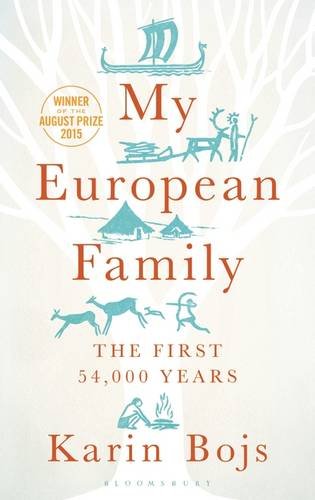I have recently read the book My European Family: The First 54,000 years (2015), by Karin Bojs, a known Swedish scientific journalist, former science editor of the Dagens Nyheter.

The book is informed, it shows a balanced exercise between responsible science journalism and entertaining content, and it is at times nuanced, going beyond the limits of popular science books. It is not written for scholars, although you might learn – as I did – interesting details about researchers and institutions of the anthropological disciplines involved. It contains, for example, interviews with known academics, which she uses to share details about their personalities and careers, which give – in my opinion – a much needed context to some of their publications.
Since I am clearly biased against some of the findings and research papers which are nevertheless considered mainstream in the field (like the identification of haplogroup R1a with the Proto-Indo-European expansion, or the concept of steppe admixture), I asked my wife (who knew almost nothing about genetics, or Indo-European studies) to read it and write a summary, if she liked it. She did. So much, that I have convinced her to read The Horse, the Wheel, and Language: How Bronze-Age Riders from the Eurasian Steppes Shaped the Modern World (2007), by David Anthony.
Here is her summary of the book, translated from Spanish:
The book is divided in three main parts: The Hunters, The Farmers, and The Indo-Europeans, and each has in turn chapters which introduce and break down information in an entertaining way, mixing them with recounts of her interactions and personal genealogical quest.
Part one, The Hunters, offers intriguing accounts about the direct role music had in the development of the first civilizations, the first mtDNA analyses of dogs (Savolainen), and the discovery of the author’s Saami roots. Explanations about the first DNA studies and their value for archaeological studies are clear and comprehensible for any non-specialized reader. Interviews help give a close view of investigations, like that of Frederic Plassard’s in Les Combarelles cave.
Part two, The Farmers, begins with her travel to Cyprus, and arouses the interest of the reader with her description of the circular houses, her notes on the Basque language, the new papers and theories related to DNA analyses, the theory of the decision of cats to live with humans, the first beers, and the houses built over graves. Karin Bojs analyses the subgroup H1g1 of her grandmother Hilda, and how it belonged to the first migratory wave into Central Europe. This interest in her grandmother’s origins lead her to a conference in Pilsen about the first farmers in Europe, where she knows firsthand of the results of studies by János Jakucs, and studies of nuclear DNA. Later on she interviews Guido Brandt and Joachim Burguer, with whom she talks about haplogroups U, H, and J.
The chapter on Ötzi and the South Tyrol Museum of Archaeology (Bolzano) introduces the reader to the first prehistoric individual whose DNA was analysed, belonging to haplogroup G2a4, but also revealing other information on the Iceman, such as his lactose intolerance.
Part three, dealing with the origin of Indo-Europeans, begins with the difficulties that researchers have in locating the origin of horse domestication (which probably happened in western Kazakhstan, in the Russian steppe between the rivers Volga and Don). She mentions studies by David Anthony and on the Yamna culture, and its likely role in the diffusion of Proto-Indo-European. In an interview with Mallory in Belfast, she recalls the potential interest of far-right extremists in genetic studies (and early links of the Journal of Indo-European Studies to certain ideology), as well as controversial statements of Gimbutas, and her potentially biased vision as a refugee from communist Europe. During the interview, Mallory had a copy of the latest genetic paper sent to Nature Magazine by Haak et al., not yet published, for review, but he didn’t share it.
Then haplogroups R1a and R1b are introduced as the most common in Europe. She visits the Halle State Museum of Prehistory (where the Nebra sky disk is exhibited), and later Krakow, where she interviews Slawomir Kadrow, dealing with the potential creation of the Corded Ware culture from a mix of Funnelbeaker and Globular Amphorae cultures. New studies of ancient DNA samples, published in the meantime, are showing that admixture analyses between Yamna and Corded Ware correlate in about 75%.
In the following chapters there is a broad review of all studies published to date, as well as individuals studied in different parts of Europe, stressing the importance of ships for the expansion of R1b lineages (Hjortspring boat).
The concluding chapter is dedicated to vikings, and is used to demystify them as aggressive warmongers, sketching their relevance as founders of the Russian state.
To sum up, it is a highly documented book, written in a clear style, and is capable of awakening the reader’s interest in genetic and anthropological research. The author enthusiastically looks for new publications and information from researchers, but is at the same time critic with them, showing often her own personal reactions to new discoveries, all of which offers a complex personal dynamic often shared by the reader, engaged with her first-person account the full length of the book.
Mayte Batalla (July 2017)
DISCLAIMER: The author sent me a copy of the book (a translation into Spanish), so there is a potential conflict of interest in this review. She didn’t ask for a review, though, and it was my wife who did it.